Out, damn Spotify!
Much like Lady Macbeth, Kim has found herself sleepwalking in her enormous castle unclear how she ended up covered in blood (by indirectly funding a military drone company). Read on to discover how she rid herself of Spotify and rediscovered her love of music, albeit with a distinct lack of witches.
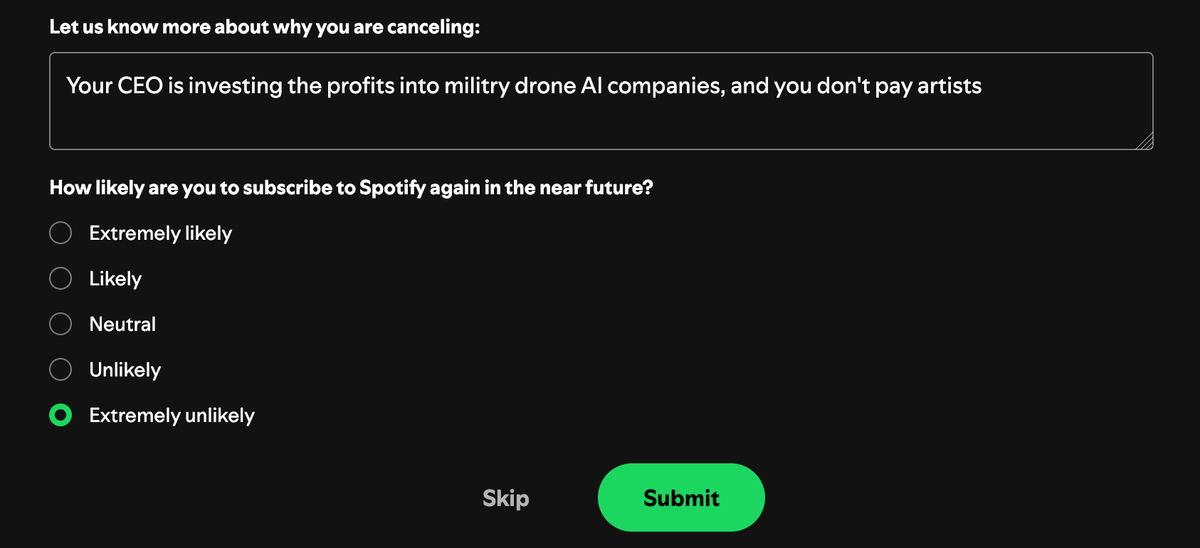
The last decade or two has seen a rapid shift from us owning our computers, media and software to renting it from billionaires. What started as convenient and fun new services are now corporate monoliths changing the shape of entire industries for the worse, and alienating us from one another.
Spotify is one example of this. Launched in 2009 in the UK, what was initially incredibly exciting – access to an enormous catalogue of music on your phone with a small monthly subscription – felt like the inevitable conclusion of the iPod and iTunes, a vision of a global future where music could spread across the world at the click of a button.
Of course, as we know now, while this is technically true, the awful capitalist downside was that they'd simply decide to give literal peanuts back to artists and keep hiking the price. Worse, the CEO Daniel Ek has invested these profits from ripping off artists into an AI military drone company, resulting in a growing number of artists pulling their music from the platform entirely in a particularly violent example of enshittification. So what next for fans of music who don't want to fund the most violent excesses of the military industrial complex?
Music distribution in the noughties
When I was in my teens and twenties like a lot of millennials I spent hours perusing CDs in Virgin Megastores and HMV, and later independent shops like Selectadisk in Nottingham (where a very enthusiastic clerk explained Hüsker Dü to me) and Jumbo Records in Leeds. At some point Fopp came around and was selling CDs for a fiver. When I was still living at home with my parents music was probably the main thing I spent money on and like a lot of my peers I grew a pretty huge collection.
At this point distribution was the hot topic on peoples' lips the indie scene couldn't quite ever match corporations for. Accessing new music, especially from other countries, required an array of mailorder catalogues and one-person operations printing CDs and vinyl and shipping out internationally. One or two sentence descriptions of what bands sounded like, and small record labels' reputations for putting out good music was all we had to go on. Labels like Dischord became DIY institutions.
As a result a micro industry sprung up of small community level record distros – as I mentioned in my blog intro I ran one of them in the early noughties. We'd order wholesale from labels and resell it for break even or a small profit as part of the fandom. At most DIY shows you could expect to see a bit of a village fete's worth of people set up shop on foldable trestle tables, with a couple crates of vinyl and some stacks of CDs, where you could buy these records during the breaks in the show.
At some point Napster, Limewire and later DC++ and Bittorrent came around and for the DIY scene it was pretty transformational. You have to understand most of these bands were incredibly happy people were now able to hear their music and were generally anti-copyright. People understood that downloading an album was a first step, and not a replacement for, buying it! Obviously the major labels and Metallica disagreed but the downloads continued.
When I was younger and much cooler I rememeber hosting Tobi Vail from Bikini Kill in the Queer Mutiny squt when her new band Spider and the Webs formed. She commented that they never expected Bikini Kill to be this huge global hit, she thought people would see what they were doing and how easy it was to make music and people would make their own bands in their own cities and go see them instead. With hindsight I wonder how much that Olympia scene was made globally famous through having both organised distro via Buy Olympia (which seems to no longer stock music!), and these early days of downloads. Most cities never got so organised.
Like most things though the final end to this era wasn't state legal apparatus – but rather the commercial alternative being good enough people were happy to pay for it. The Spotify plan I'm on for me and my partner is £17 a month currently (with a quid getting added whenever Spotify feels like it). I probably used to spend more than this a month on music but then I owned it for good, and perhaps more importantly had some kind of relationship with the artist and label as a result. Spotify's original unique selling point, much like DC++ at its peak, was discovery – all I need to do is type in an artist and I can probably access their entire discography. But then of course soon enough I stopped buying music and starting “following” artists on Spotify instead, and the interim years are, as they say, history.
We've got Spotify at home
So, finally to the point of this blog post – I've been working out how to take back control of my own music collection and rematerialise my understanding of music and the indie and DIY music industry in the process.
It turns out that Spotify was doing quite a bit in it's own one-app-to-rule them all way:
- Discovery. Showing me artists I might like and suggesting new music.
- Update notifications. Letting me know when people I follow release new music.
- Library management. Keeping track of my favourite artists and songs.
- Storage and streaming. Managing all those files on all those servers so I can access them from anywhere.
- Apps. Providing phone and desktop apps to let me play the music.
- "Smart" speaker integration. Working nicely with my various hodge podge of devices: namely some old Sonos 1s, a 15 year-old Marantz A/V tuner, and a more recent WiiM tuner attached to some old studio monitors in the kitchen.
Replacing all these things took quite a few bits! Please note that this is not a tutorial but rather a guide to what it involves and I cannot offer any support if you choose to do this yourself.
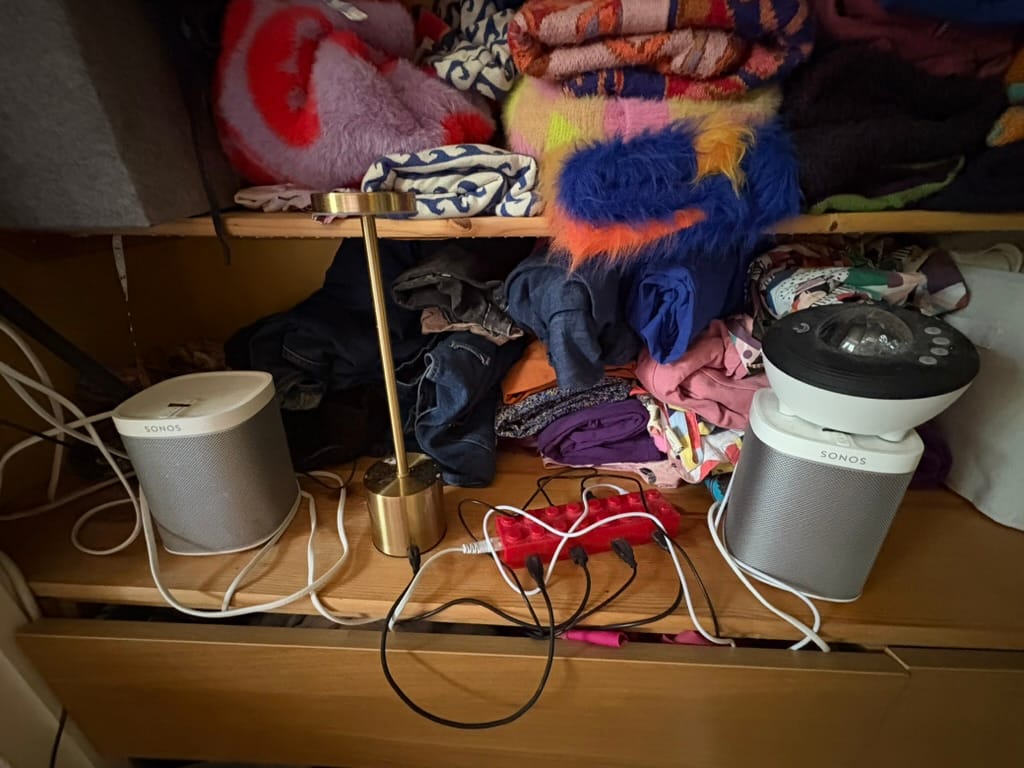
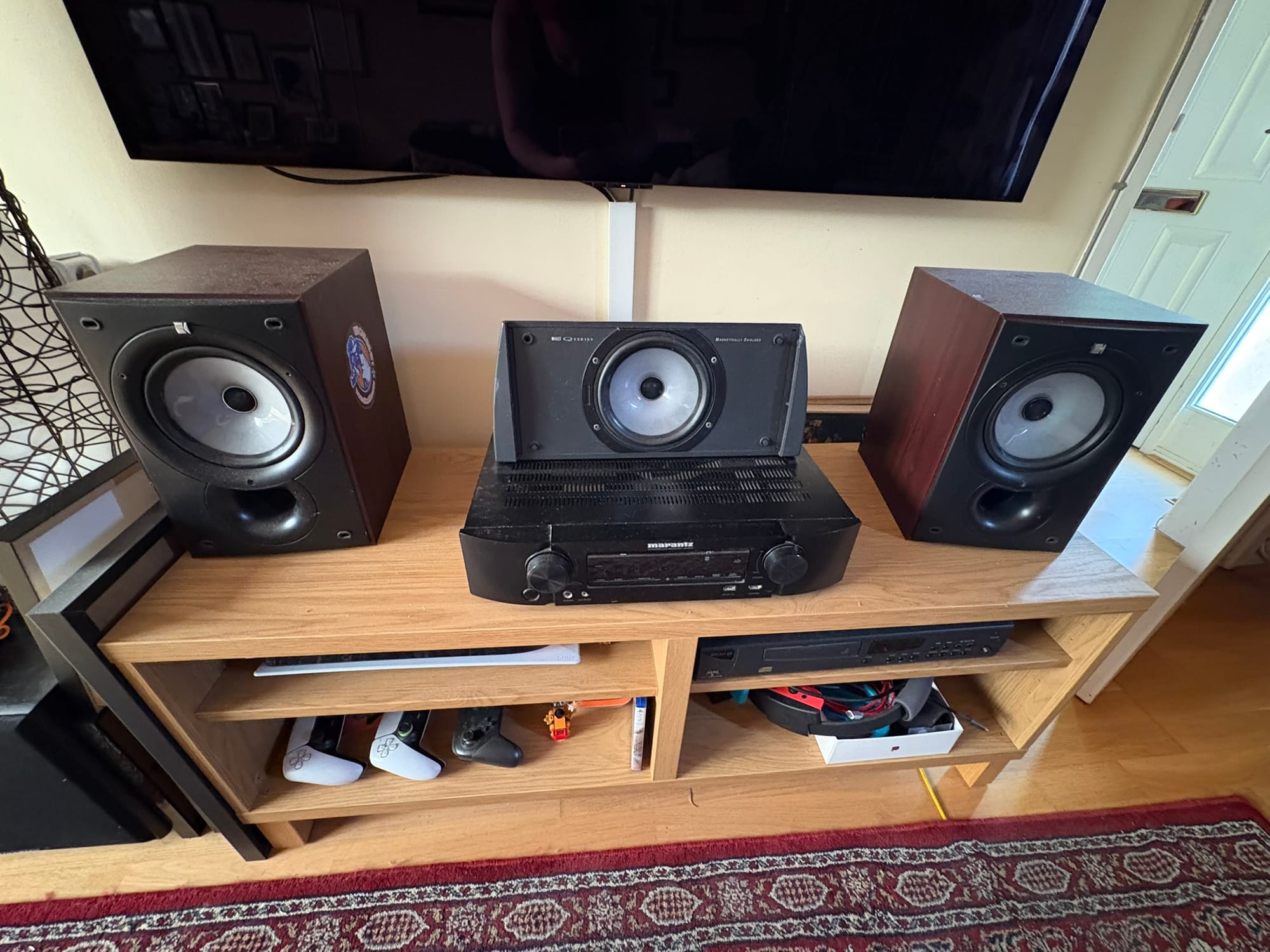
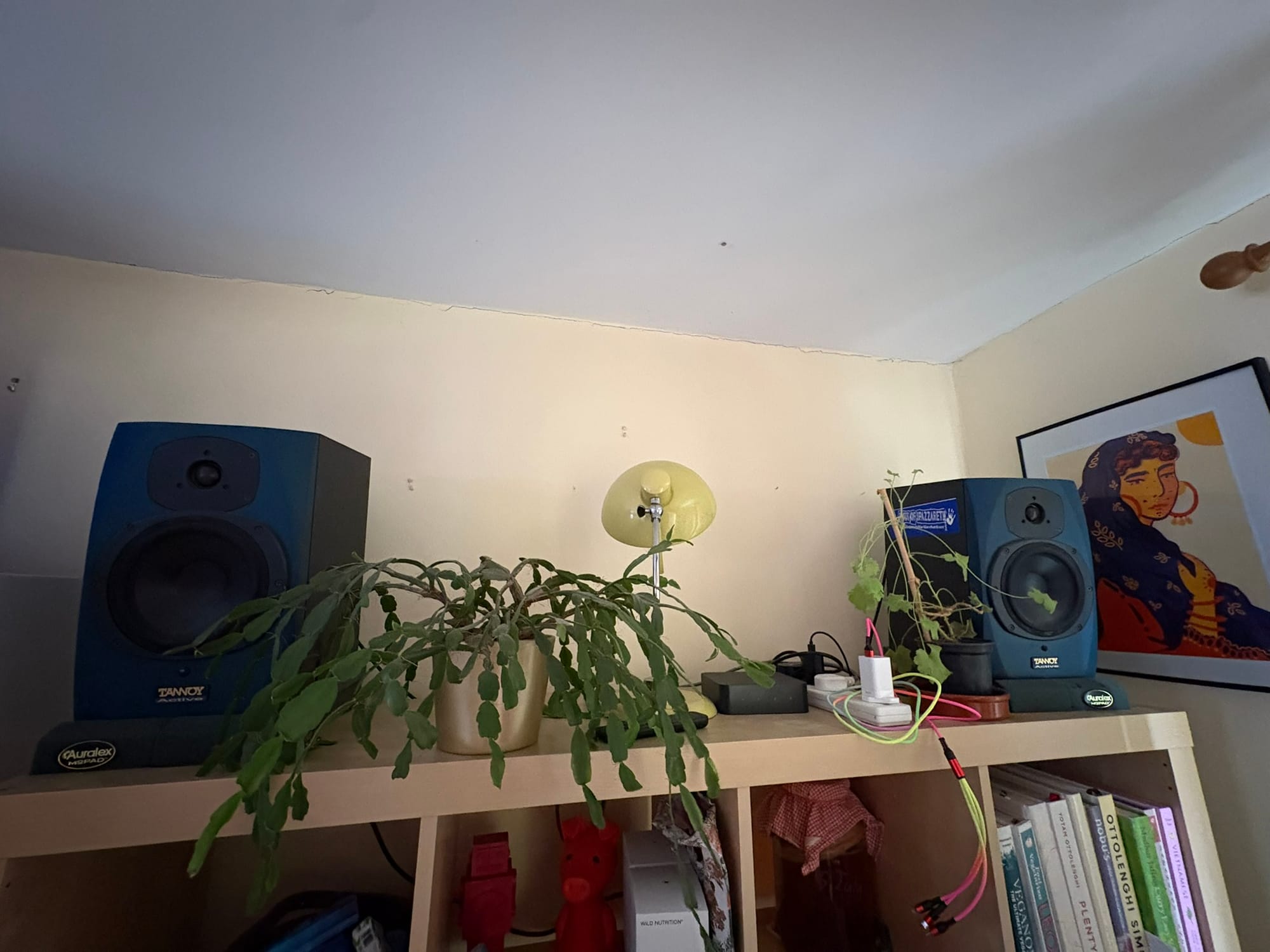
My current slightly janky house setups (L-R). Two Sonos speakers in my bedroom, Kef speakers and a Wharfdale sub in the living room connected to a Marantz A/V tuner, and Tannoy Active monitors connected to a WiiM Airplay amp in the kitchen.
Storage
My NAS (network attached storage) was very very long overdue an upgrade, and had been running a probably quite ill advised XPenology setup. I needed to do this for work anyway (I promise your honour) so I splashed out on a new Synology NAS with a few bays. The killer feature this had that my previous one didn't is the ability to run Docker containers and VMs, which I knew I'd need to run some of the services to get this up and running.
I've had a bad time previously trying to manage music on USB drives or single hard drives and having files go missing or get corrupted, so I kept my existing 2-drive RAID array for music and got a large capacity single drive for things I care less about having backups for like Time Machine (my laptop is the second backup for that) and videos I'm processing for work that don't need long term storage.
Of course if you have the time and inclination I'm sure you can do all this much more cheaply on a homelab-style Linux box, but I value my time and stability more than having access to all the options nowadays and Synology has been incredibly stable for me so it was an easy decision for me.
Library
After some web search it seemed like Navidrome was the current favourite as a media server. It provides all your music in an open API format called Submarine that is compatible with a range of players. I set it up using the official Docker image on my Synology NAS.
This worked pretty flawlessly out the box as soon as I remembered how to set up docker drive mappings. You can play your music in a browser with a local port, but it has no option to stream to any network devices.
Discovery
This is the tricky bit. There's a tool called Lidarr that can be used to track artists' releases but it's very tied into that info coming from illegal downloads on usenet and torrents. Specifically, you need a subscription to a range of tracker sites to be able to use this which I'm uncomfy with.
The best alternative I can find right now that lets you follow artists is Bandcamp where I'm planning on buying some music from – but obviously a lot of artists are on here and even the ones that are don't put all their music on it. I think Spotify possibly has everyone beat here and I may continue to use it for discovery even after cancelling my paid subscription. I guess I probably need to start following the music press again!
Apps and smart devices
In typical open source fashion, there is a wide range of apps that will play music over the Subsonic API Navidrome provides, which all do some things you want and not all. I'm using an iOS app called Amperfy and an Android one called Symfonium, and they both work great.
The one thing that doesn't work is streaming to my Sonos speakers. I'd like to de-influence everyone against Sonos devices: the vendor lock-in is terrible and I've had them semi-bricked more than once after a firmware update, but I'm stuck with them for now. In the end the only way to stream to them I've found is the Music Assistant add on for Home Assistant, which I had also added to my NAS (and is a story for another day). This is a bit clunky and I hope Sonos support pops up mysteriously in a future update.
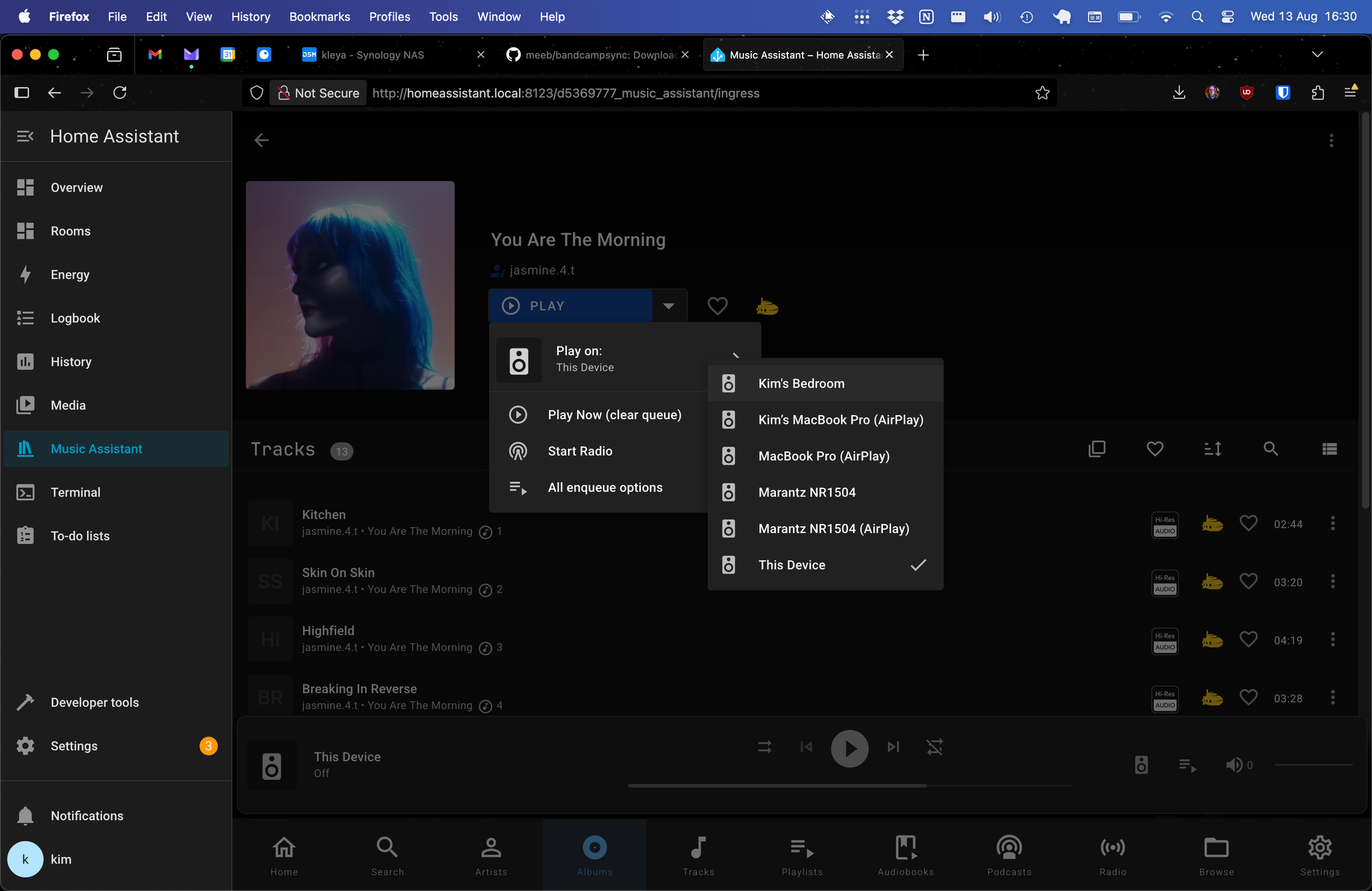
Streaming
Streaming in the house is not a problem and the server can be accessed on a local URL. To get access to this out the house I've employed Tailscale, which the GFSC Discord very patiently explained to me is a way to set up a secure VPN between your households' devices. Tailscale gives me an IP and local domain that means I can play my music off my home server when on the road and it has a generous free plan for up to 3 users and 100 devices which is fine for me needs.
Most of the music apps have a “download to your phone” option too, but it's so nice having full-library access on the move.
Purchasing and syncing to my library
UK law changed in 2015 to make it illegal to make a personal backup of your CDs. This to me is completely bonkers but what can you do. You now need a separate digital license to play your music on a digital device. Yes, this means iTunes technically prompts you to commit a crime every time you insert a CD.
I have a few CDs that I think are exempt: friends demos, records from anti-copyright punk labels, music from DIY labels I know have gone bust, and anything with a Creative Commons license on it. To rip these I used dbpoweramp (following their very detailed setup instructions) and a couple of £20 external USB CD drives which worked brilliantly. For those of you in more legally sane juristictions you'll have a bit more freedom here to rip your music wholesale.
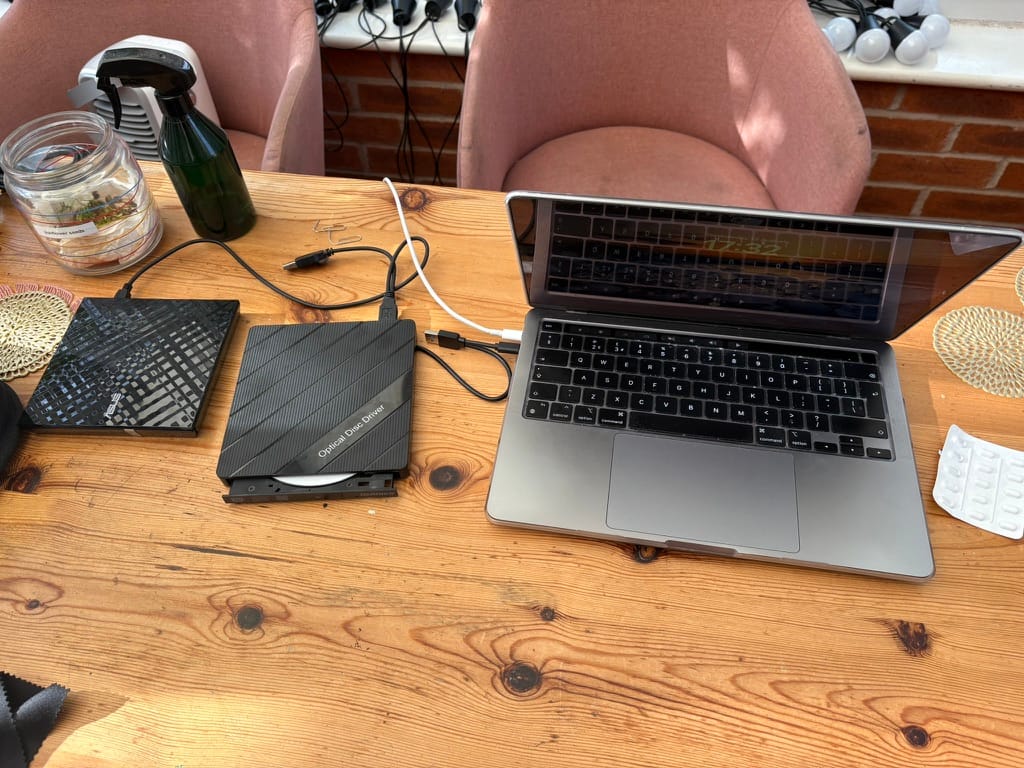
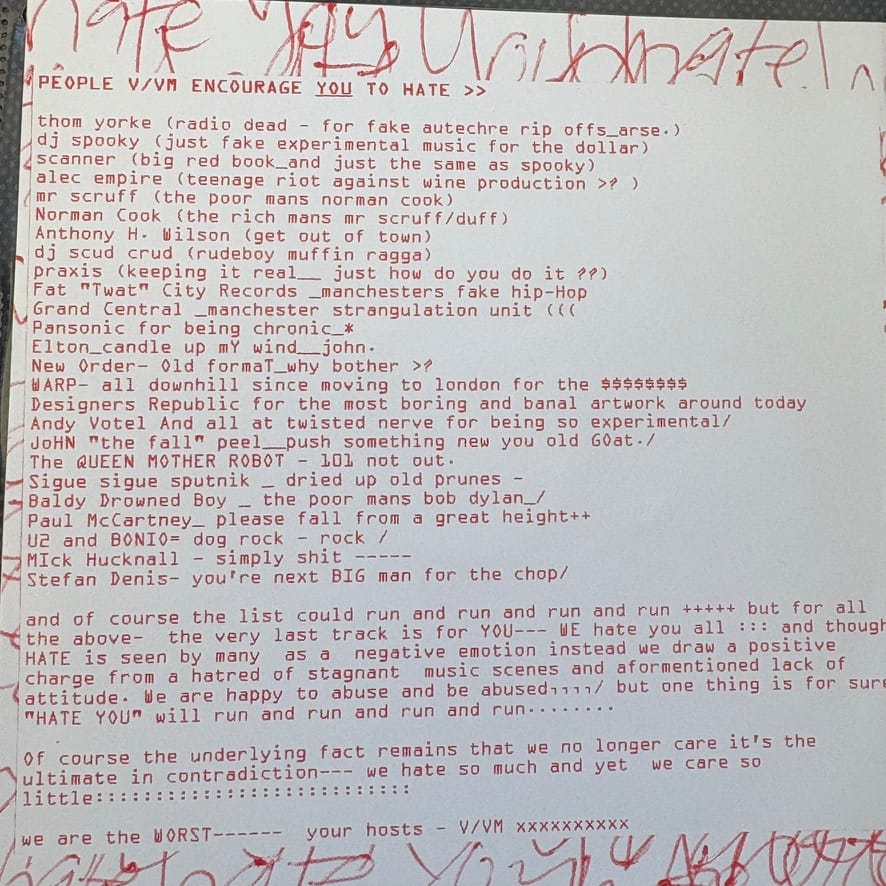
L: My laptop and some USB CD drives. R: An inlay from V/Vm test records who I am 100% sure do not care about me ripping their CD
I'm now going to spend the £17 a month I was on Spotify on buying the music I've listened to a lot on there digitally. The two best places I've found for this are Bandcamp for indie releases (even if their checkout is a bit janky) and 7Digital for more commercial releases. The final step was setting up a Bandcamp library downloader tool to sync my Bandcamp purchases directly to my NAS.
And hey presto! I have Spotify at home!
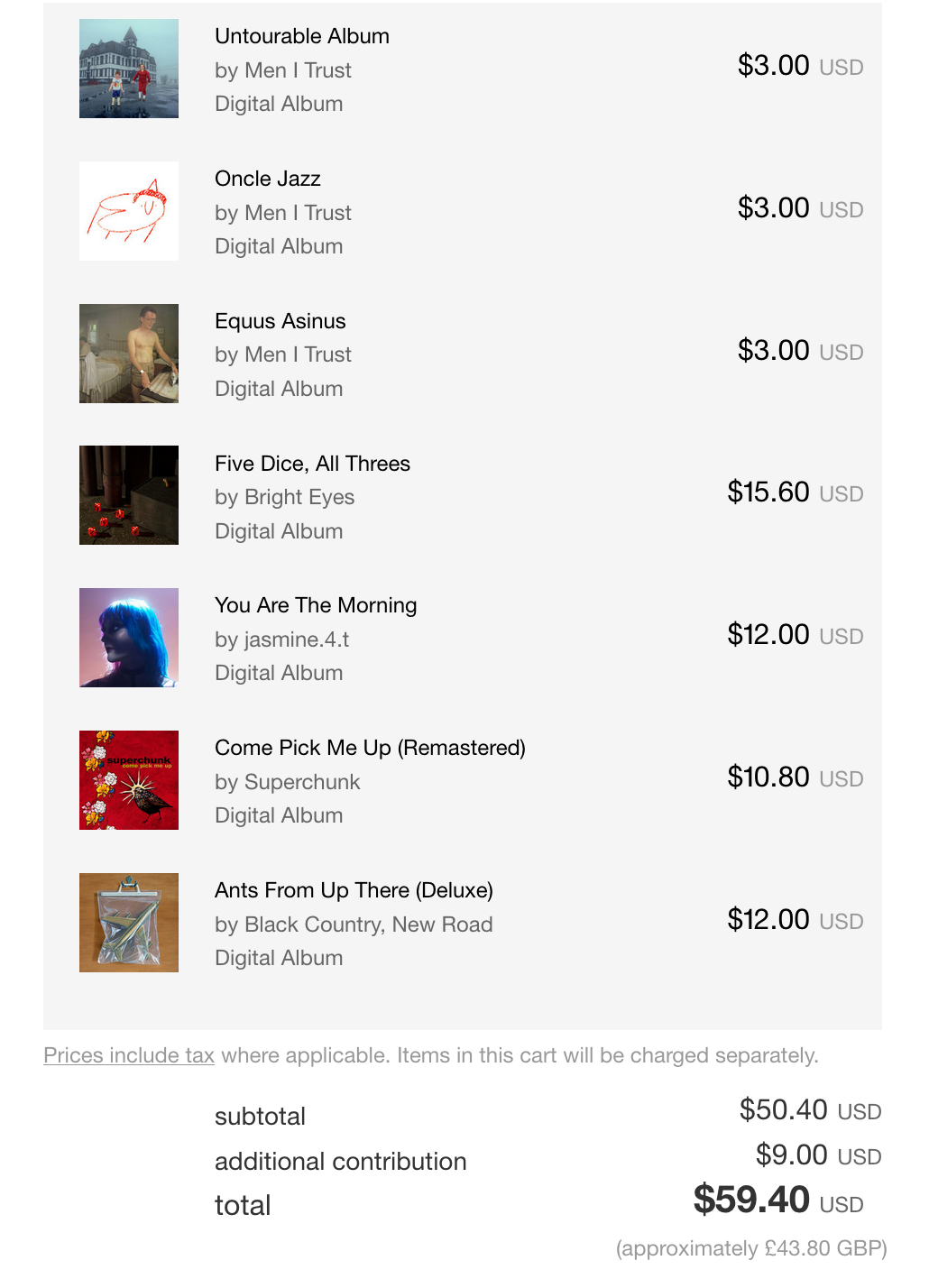
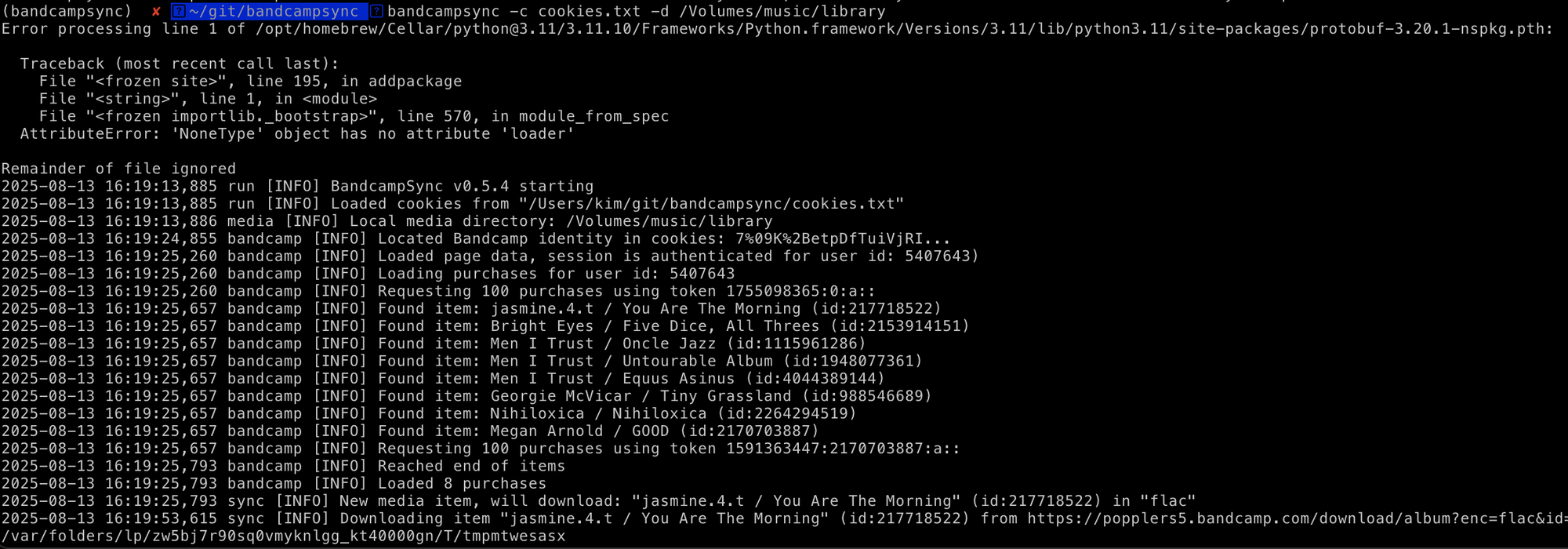
L: My first reciept showing getting 6 albums for the price of a couple months' Spotify subscription. R: a terminal output showing the bandcampsync tool in action
PHEW THIS WAS A LOT
All in all this probably took a week of faffing to set up and I've still not found a music player I like. Was it worth it? For me, yes. Getting back on Bandcamp and getting sales reciepts from labels is really reminding me how much I miss the indie and DIY scene as a whole. It reminded me that I love following record labels and owning releases, and feeling each release as more of an event, a treasured occasion, rather than a billion dollar corporation adding a billionth row to a database.
I increasingly don't want to own physical things: for me, I don't need more CDs or vinyl records even if they are very nice to have, my house has enough shit in it and I don't feel the need to be a “collector” any more as the worlds' precious resources are dwindling. For me a lossless audio file is a perfect format and I'm happy to be back in control of my music spending habits again. I might be biased now I've put all this work in but I'm positive it sounds much better too!
The main features I'm gonna miss are how easy it is to make a playlist and share it with someone, or to have a playlist for a party or event where everyone can access anything they like. My setup doesn't have an obvious replacement, but I can see it opening up some really interesting discussions about this next time I host something. Maybe friends could bring their DRM-free music on a USB stick and we can put it on the NAS and add it to the playlist? It is deffo impossible to mix Spotify and non-Spotify sources, so maybe the benefits are yet to be seen and I'm looking forward to being able to listen to all the music that's not on Spotify again without having to do it in an awkward browser tab.
This obviously isn't the most feasible route for anyone without a chunk of cash to spend on a new NAS, confidence using Docker and configuring things in the terminal, and a week to blow setting it all up. I'd love to see a future though where we have community Navidrome libraries or the like that let people connect to listen to local artists or DIY labels. I'd also love to see all this process made much easier so everyone can start owning their own music again.
Goodbye Spotify. I hope your CEOs finds himself on the business end of one of his own drones.
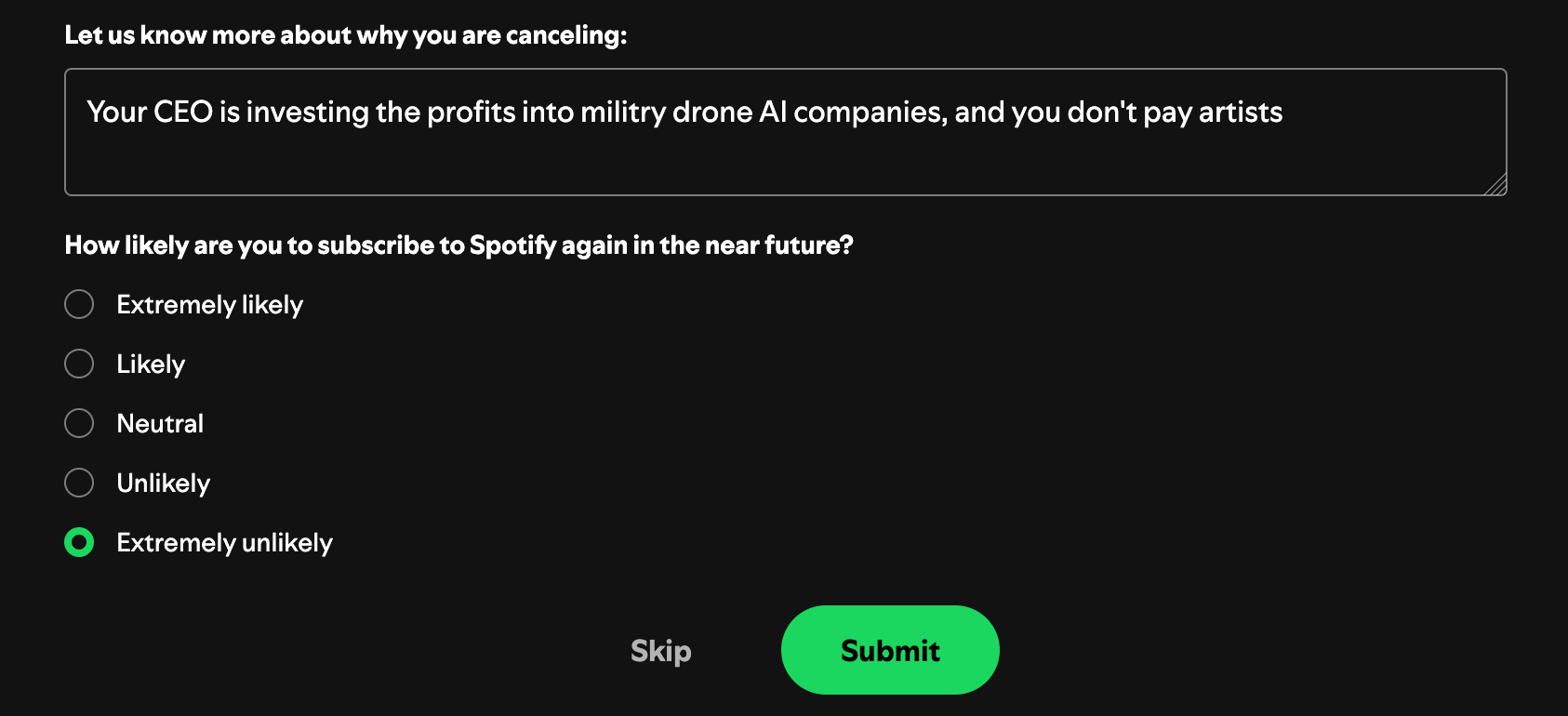

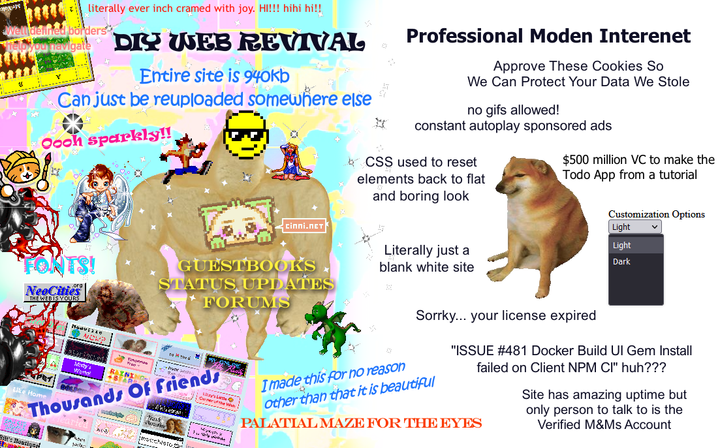

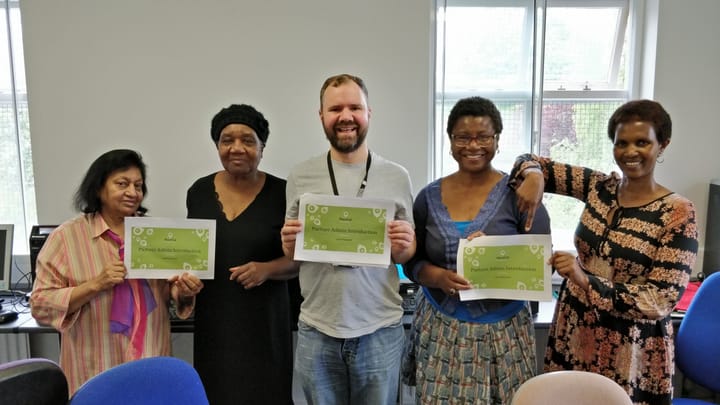
Comments ()